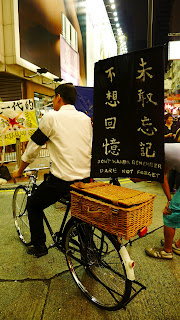only learning about it through oral narratives from older family members, the calls from democratic political parties (don't be fooled by the Democratic Alliance for the Betterment of Hong Kong, the DAB, despite them having the word 'Democratic' in their name. They are incredibly pro-Beijing, and in 2007 their ex-chairman Ma Lik tried to play down the killings that took place in Tiananmen), the media, and from the internet. Unlike in mainland China, the term '六四' (Chinese for June 4th) is not taboo, nor risky to use in the face of authorities; one could say that the current youths grew up alongside this term, and thus June 4th is cemented within the youth psyche.
But what exactly does June 4th mean for youths? Without bearing direct witness and only relying on secondary sources, can the meanings from 1989 transcend into the present day? Or is it even important to keep the same meaning from the past; can the youths of today's Hong Kong create their own connection towards June 4th? (And is it enough to just be aware of the killings, and not to engage with it?)
This is what some Hong Kong youths try to address; one such effort manifests as an art performance on the streets of Causeway Bay, known as 這一代的六四. (Having to use the phrase 'art performance' as a way of describing it shows the limitations of the English language. The word 'performance' denotes a show meant for an audience, and contains a degree of entertainment value. The Chinese phrase used is '街頭藝術活動' which can be roughly translated to 'action of art' on the streets.) This is its third year in the running, where a group of youths (and some non-youths with a youthful spirit) with and without art training will stand on the street for two hours expressing their views and understanding of June 4th. There are a range of different art practices at play; performative art, contemporary dance, choir song, poetry reading, and paintings placed on the roadside for view.
Some displays leaned towards the literal (harkening to the imagery of the Tiananmen tanks), others more abstract. Some worked together in groups, others alone. Some appeared to be a commentary on the killings and repression of 1989, others touching upon a more personal narrative. Some spoke of Beijing, others transcended the matter of site and focused on the practices of the Hong Kong mentality. Check out some photos:
People who encountered this performance may not necessarily understand or interpret what is going on (nor will I profess to have encompassing insight about all of it either), but then it seems superficial to assume that the various happenings of the night is only devoted to the entertainment or gratification of the passing public. (And so leads to a much bigger issue of about the nature of art itself, and the state of art education in Hong Kong...topics that I'm nowhere near qualified to ramble on about.)
The street performance shouldn't be construed as a separate way of remembering June 4th, breaking away from the annual candlelight vigil at Victoria Park organized by formalized organizations, institutions, and political parties; many of the performers will also take part in that as well (this art event took place on the 3rd of June, so that there will be no clashes.) You could call it a supplement to the more 'mainstream' ways of remembering 1989, allowing a new avenue to explore and interact with this bit of unresolved history.
People who encountered this performance may not necessarily understand or interpret what is going on (nor will I profess to have encompassing insight about all of it either), but then it seems superficial to assume that the various happenings of the night is only devoted to the entertainment or gratification of the passing public. (And so leads to a much bigger issue of about the nature of art itself, and the state of art education in Hong Kong...topics that I'm nowhere near qualified to ramble on about.)
The street performance shouldn't be construed as a separate way of remembering June 4th, breaking away from the annual candlelight vigil at Victoria Park organized by formalized organizations, institutions, and political parties; many of the performers will also take part in that as well (this art event took place on the 3rd of June, so that there will be no clashes.) You could call it a supplement to the more 'mainstream' ways of remembering 1989, allowing a new avenue to explore and interact with this bit of unresolved history.





No comments:
Post a Comment